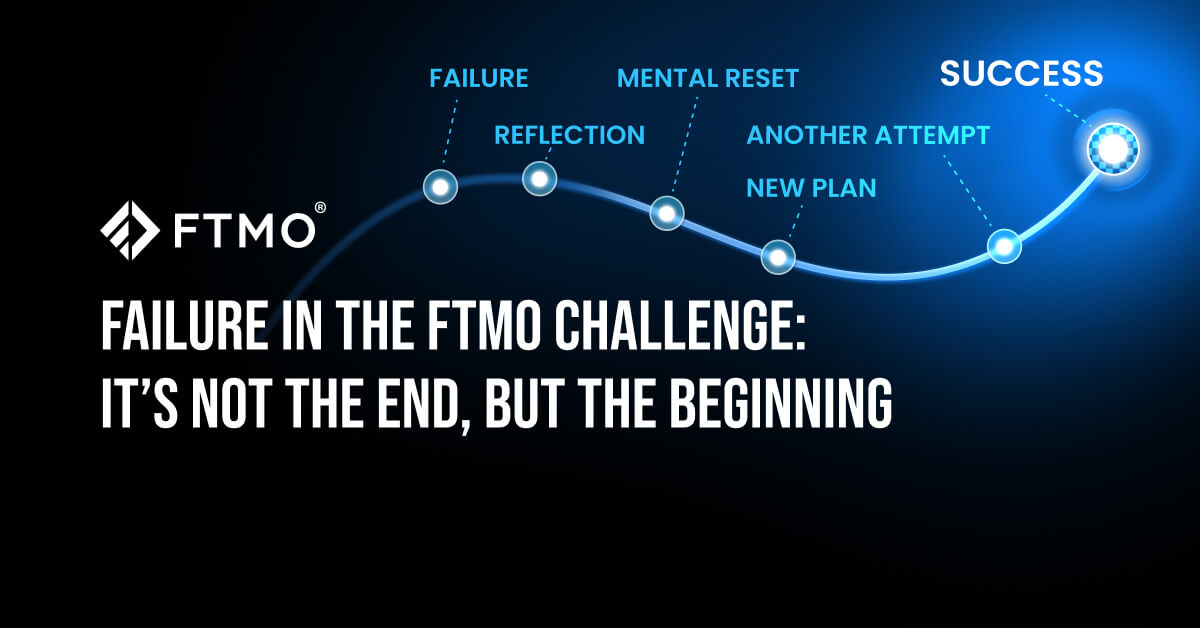
Failure in the FTMO Challenge: It’s Not the End, but the Beginning
Failure in trading is not a topic people talk about easily. Yet everyone who takes trading seriously will encounter it sooner or later. And it can come at the exact moment you decide to take the FTMO Challenge – a challenge that will test not only your strategy but, above all, your mental resilience and ability to handle pressure.
Some people start doubting themselves after failure. Others feel anger – at the market, the rules, or the results. What unites everyone is frustration, which is understandable. Failure hurts. And how you respond to it will determine whether it moves you forward or stops you on your journey.
Failure is Normal
The FTMO Challenge is a true test of trading skills. It is a test that also evaluates how you make decisions under pressure and how you handle uncertainty. Failure does not mean you are not good enough. It means you have hit your limits – technical, mental or emotional. And these limits show you where there is room to grow.
Many look for a flaw in the system. But what moves a trader forward is self-reflection. Ask yourself the following questions: Am I reacting with discipline? Can I stick to the plan even when I’m going into a loss? Can I manage risk with composure? You’re more likely to discover the answers to these questions through failure than through a series of successes. Finding these answers can lay the foundation for your next step forward.
What Can the FTMO Challenge Actually Teach You?
The FTMO Challenge is not just a test of rules and numbers. It is an experience that gives you a real picture of how you actually trade. It teaches you to handle pressure. It shows you how you behave during a series of losses. Thanks to it, you’ll find out whether you truly trust your own plan and system, even in moments when things are not going smoothly. And it also helps uncover the situations where you deviate from your plan, often without realising it.
You will gain data about yourself that you might overlook on a demo account:
• When impulse takes over and when you maintain discipline
• How you handle drawdown, limits, break-even or small profit
• When you enter a trade based on strategy and when it’s based on emotion
How to Process Failure and Prepare for a Better Restart?
Failure doesn’t mean you don’t have what it takes. It means you now hold something priceless: feedback and experience. And if you use them wisely, your next attempt can be not only better but also more realistic. Some traders dive into another challenge immediately after failure. Motivation might be high, but impulsive decisions without reflection often lead to the same outcome. A true restart is when you try again but differently. Thoughtfully. Consciously. With a better plan.
Ask yourself:
• What was the biggest weakness of my last attempt?
• Where was my performance strong, and how can I use that?
• Do I have a new plan or just the same approach with a fresh start?
Can you answer these questions now? Or do you want to sort out your thoughts first during a few days of calm reflection? A new attempt doesn’t have to be just a correction. It can be the beginning of a new approach to trading. And when that moment comes, even today, it’s time to try again: with a clearer head, a better plan, and the awareness that this time, you know yourself better than ever before.
Look Back and Analyse!
Once the initial disappointment fades, a phase begins that decides whether failure becomes stagnation or progress: reflection based on data. It’s not enough to say, “It didn’t work out.” It’s important to understand why it didn’t work and look back not only at your emotions but especially at what the numbers are saying.
Focus on these key indicators during your review:
• RRR (Reward-Risk Ratio): Did the ratio between potential profit and risk match your strategy? Or did you often enter trades with an unbalanced RRR under emotional pressure?
• Win Ratio vs. Effectiveness: Did you have a high win rate but low overall profit? Or fewer winning trades but highly profitable ones? The balance of these metrics reveals whether your strategy is sustainable in the long run.
• Maximum drawdown: When did your biggest drop occur, and what caused it? Was it individual mistakes or a series of rule violations?
• Daily limits: Did you exceed your daily loss limit? If so, it may signal poor planning or an attempt to “force the result”.
• Timing of trades: When do you make the most mistakes? Morning, afternoon, or after a series of losses? These patterns are key to setting up your trading routine more effectively.
You can use our improved tool, Live MetriX, for this analysis – it helps uncover recurring mistakes, analyse your behaviour, and gain an objective view of your decisions.
Are You Ready to Try Again but Differently?
Failure in the FTMO Challenge can be a valuable experience. If you can view it as a prompt for self-reflection, it can move you further than success ever could. Now you know how you react under stress, when you act impulsively, and how well you manage to stick to your plan. And that may be the very difference between a trader who just tries and one who trades consciously.
After a failure, you can return stronger. You return as a trader who knows what needs to change and is ready for it. Begin with awareness, not with doubt.
About FTMO
FTMO developed a 2-step Evaluation Process to find trading talents. Upon successful completion you can get an FTMO Account with a balance of up to $200,000. How does it work?.










